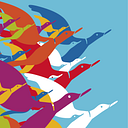Finding and Sharing the Vision
This is an excerpt from the Social dimension of Gaia Education’s Design for Sustainability curriculum.
Techniques to Create a Common Vision
There are different techniques for creating a common vision. The Futures History method we present here is a simplified version of the method developed by Warren Ziegler. Participants need drawing materials and space to work in. The exercise may last from a few hours to several days, depending on the group.
With this method, a move towards a consensus vision can be made. A small group takes the posters prepared in Step 3 and works through them to spot the common ground. Ideally, this group will have whole systems design skills and will be able to draw up a set of proposals for achieving many elements of the collective vision. The larger group will meet again later to review these proposals and split into working groups to act on them.
Step 1. Imagine and draw something of your vision for your project 10–20 years later.
Step 2. Join with others in a small group of 3–4 people, to listen and look at each other’s thoughts for your future. Do this one at a time, with equal time for everybody, then feedback something you like about each other’s work and something that you have learnt.
Step 3. In your group, take time to develop a new vision using the fresh perspectives and insights you have gained. Create a poster to illustrate the essentials of your vision, with all common elements in the centre and main discrepancies on the side.
Step 4. Post your collective vision on the wall for gallery time in which you may ask each other questions. To each person you speak with, feedback something you like about their work. Notice which are common elements you agree with, and which are your main discrepancies.
Step 5. Create a final poster that gathers all common elements in a new vision. Make a list of the main discrepancies that emerged during this process. Dedicate some time to discuss your discrepancies and look for agreement or possible ways to address them.
Step 6. Spend time in pairs working on finding the next achievable step towards your vision. Create a future history by imagining yourself actually in the future vision now. From that position ask yourself, “how did this come about? How did it happen?” Take time telling each other the story, take notes for each other and prompt your partner to a positive, personal action plan for initiatives to act on soon.
Step 7. Each person imagines being engaged in that action, by seeing the sights, sounds and feelings to ground it. Do this one at a time, taking equal time.
The International Institute of Facilitation and Change, IIFAC, proposes this beautiful and practical experience of creating a Common Vision through the words and drawings of the participants.
This is an excerpt from the Social dimension of Gaia Education’s online course Design for Sustainability.
If you would like to learn more about how to learn the skills to become a confident change maker in social issues of sustainability, then you should join our Social Design online course.
In the Social Design course, you will also learn more about how to deal with conflict and diversity — of ideas, beliefs, roles, etc., how to improve your communication skills and communicate in a more compassionate way, how to create a common vision for a collective project, and much more!
Read more about the upcoming Social dimension starting 12 October 2020 here!
If you register early, you are able to get a special discount.
If you liked this post and would like to see more posts like this, please clap by clicking the clap button below.
We would appreciate it if you would share this with your network.
Gaia Education is a leading-edge provider of sustainability education that promotes thriving communities within planetary boundaries.
